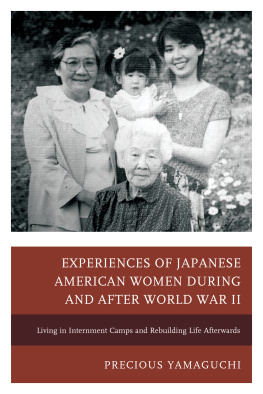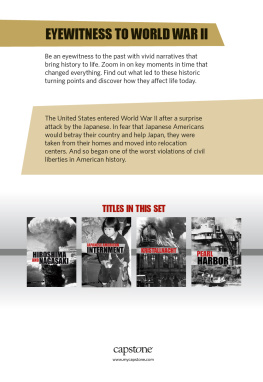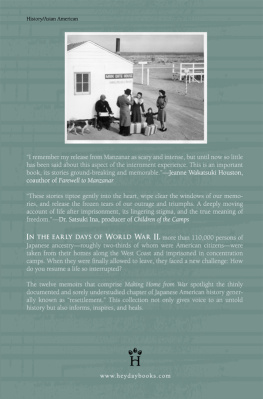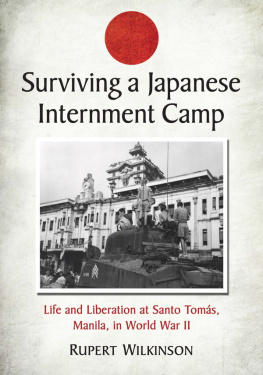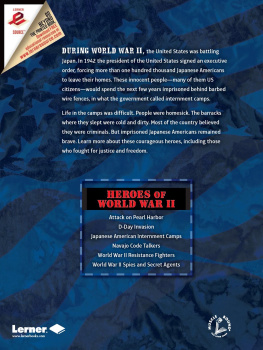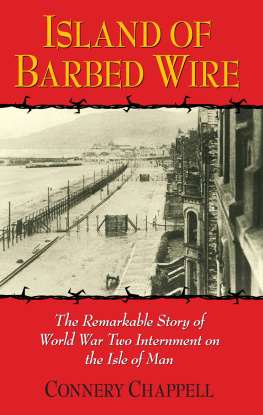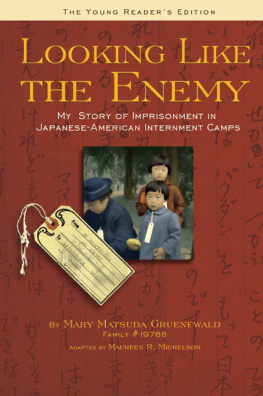

LOOKING LIKE THE ENEMY:
My Story of Imprisonment in Japanese-American Internment Camps
Copyright 2005 by Mary Matsuda Gruenewald
All rights reserved. No part of this book may be reproduced or used in any form or by any means without permission from the publisher.
NEWSAGE PRESS
PO Box 607
Troutdale, OR 97060-0607
503-695-2211
website: www.newsagepress.com
Cover Photo: The cover photo was taken on March 30, 1942 by a Seattle Post Intelligencer photographer as the Hayashida family was being evacuated from Seattle. Holding the flag is Hiro Hayashida. Beside him stands his sister Susan. Behind them stands their mother, Nobuko Hayashida. Another sister (not shown) stands at Susans left. Hiro Hayashida and Susan Hayashida Furuta still live in the Seattle area. Photo courtesy of Frank Kitamoto, a nephew to Hiro and Susan.
Cover & Book Design by Sherry Wachter.
Library of Congress Cataloging-in-Publication Data
Gruenewald, Mary Matsuda, 1925-
Looking like the enemy / by Mary Matsuda Gruenewald.-- 1st ed.
p. cm.
Includes bibliographical references.
ISBN 978-0-9391-6565-0
1. Japanese Americans--Evacuation and relocation, 1942-1945. 2. Gruenewald, Mary Matsuda, 1925- 3. Japanese Americans--Biography. I. Title.
D769.8.A5G78 2005
940.531779635--dc22
2005004076
7 8 9 10
For the Isseis whose courage, devotion, and faith in the United States and in their children made it possible for our people to triumph over the internment experience. The values they passed on laid the foundation for the ultimate fulfillment of their dreams by the Nisei and future generations.


The Matsuda Family, 1933.
ACKNOWLEDGMENTS
I wish to thank the countless people who helped to make this book possible. First and foremost are the members of my original family: my mother, father and brother, all of whom died long ago, but whose memory remains vivid and central to this story. My children, Martha, David and Ray, and my nieces, Marlene, Kathryn, Marguerite and Sheila, formed the primary motivation for me to write my story late in life. My sister-in-law, Miyoko, provided inspiration, support, and specific mementos from my brothers collection of books and papers.
I am indebted to Tok Otsuka and Augie Takatsuka, who served in the 100th/442nd Regimental Combat Team with my brother. From them, I gained a better perspective of the ferocity of the battles they fought on behalf of the Allied forces and for the freedom of our people.
I will always be grateful to my special friend, Haru Ishikawa, who inspired and helped me with numerous discussions, meals shared, and books from her collection. Her untimely death deprived her of the pleasure of seeing this book come to fruition.
I wish to acknowledge Pam Woodroffe who, in writing about farming on Vashon Island in her book, Vashon Islands Agricultural Roots: Tales of the Tilth as Told by Island Farmers, devoted a chapter to my familys early years as strawberry farmers. It includes a part of my story of the internment process.
I am indebted to Mr. Ivar Nelson, formerly of the University of Idaho Press, who provided support and guidance as I moved through the initial phases of the writing of my story.
I wish to extend my special thanks to Jo Cripps, who worked with me during my initial, limited attempts at writing.
I want to formally acknowledge the crucial role of my writing teacher, Brenda Peterson. It was through her unfailing support and wise counsel that I was finally able to come to terms with my Japanese background that had been the source of unexamined confusion and pain during much of my life. Members of her writing group made major contributions to clarifying and writing my story. They include: Leigh Calvez, Claire Dederer, Liz Gruenfeld, Leslie D. Helm, Susan Little, J. Kingston Pierce, Trip Quillman, John Runyan, Dori Jones Yang, Denise Benitez, Jordan Buck, Kristina Danilchik, Cathy Englehart, Laurie Greig, Anne Hayden, Donna Kelleher, Susan Knox, Tara Kolden, Anne Mize, Trish Murphy, Ginny NiCarthy, Kimberly Richardson, Ward Serill, Julie Stonefelt, and Louise Wisechild.
I am deeply grateful for the support of Robert S. Fisher of the Wing Luke Museum and Carolyn Marr of the Museum of History and Industry in Seattle, Washington. They made it both possible and pleasant for me to include valuable photographs from their collections.
I am indebted to Liz Nesbitt, Ph.D., Curator of Paleontology, Burke Museum of Natural History and Culture. She provided invaluable information about the shells I found at the Tule Lake Internment Camp.
I wish to give special thanks to my son, Ray, who has given his heart, soul, expertise, and energy to my writing of this book. His contributions have helped me to complete this narrative that has been my focus for most of the last decade. While his time and efforts have been indispensable, it has been his interest, passion, and support that have meant so much to me. I can think of no greater gift that he could have given to our whole family and to me.
I would also like to acknowledge NewSage Press book designer, Sherry Wachter. Her exquisite design sensibilities helped bring my story to life on these pages. And finally my profound thanks must go to Maureen R. Michelson, publisher of NewSage Press, for the extraordinary editing and personal support she provided. She recognized the potential in my story and helped to transform my initial manuscript into a polished work.
MARY MATSUDA GRUENEWALD
Seattle, Washington
CONTENTS

O ne sunny day my brother, Yoneichi, and I sat on a log floating in front of our home at Shawnee Beach on Vashon Island, Washington. I was four years old and he was six.
That day in 1929 as we peacefully rode the gentle tide of Puget Sound we could not know about the impending tsunami of World War II. Thirteen years later a wave of anti-Japanese prejudice swept across the United States and forced my family to leave our secure island home and succumb to the will of a hostile and turbulent world at war. Little did I know the political storms and social upheavals that would beset my family, tear us away from our home, and confine us in internment camps simply because we looked like the enemy.
During World War II Japanese-Americans endured the wholesale violation of our civil and human rights as residents and citizens of the United States. Many would lose their homes, livelihoods, and dreams, and be left with pain, confusion, and shame. This legacy has shadowed my entire adult life.
Some seventy-five years later I gaze long and hard at this photo, recalling my innocence, joy, and security. With what I know now, how I wish I could have held that little girl in the photo and reassured her, Have faith in your family and the ultimate goodness of people. Especially have faith in yourself to survive the catastrophic events yet to come. In spite of all the terror, pain, depression, and tears in your future, you will reach a final hopeful conclusion.

Next page

